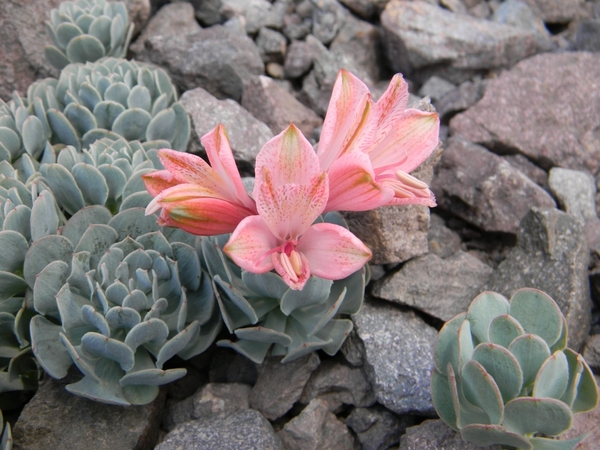If you’re a fan of unique, colorful plants that add a touch of elegance to your garden, Alstroemeria spathulata, also known as the spoon-leaf Peruvian lily, is one you definitely need to check out. This stunning plant, with its distinctive spoon-shaped leaves and vibrant flowers, can bring a burst of color and charm to any outdoor space. Let’s dive into what makes this plant so special, how to grow it, and why it's a great choice for your garden.

Alstroemeria spathulata is a type of Peruvian lily that's native to South America. The name "Alstroemeria" refers to a whole genus of plants known for their attractive flowers, but Alstroemeria spathulata stands out due to its unique leaf shape. The "spathulata" part of its name comes from its spoon-shaped leaves — a cool feature that makes this plant instantly recognizable.
The leaves of this plant are long, oval, and broad, and they give the plant a distinctive, almost succulent-like look. The flowers, which bloom in summer and fall, are equally impressive. They come in a range of vibrant colors, including shades of yellow, orange, and red, often with speckled or striped patterns. The flowers bloom in clusters and have a fun, trumpet-like shape, making them an eye-catching addition to any garden or balcony.

1. Stunning Appearance:
Alstroemeria spathulata is a showstopper. The bright, colorful flowers and unique leaf shape make it stand out in any landscape. It's a perfect plant to add some flair to your garden, whether you're looking for a bold accent in flower beds or something lovely for your patio pots.
2. Easy to Grow:
One of the best things about this plant is that it’s relatively easy to grow, even for beginners. It thrives in a variety of conditions, as long as you give it a sunny spot and well-draining soil. Plus, it's a hardy plant that can tolerate a wide range of temperatures, making it perfect for most climates.
3. Long Blooming Period:
Alstroemeria spathulata blooms for a long period, typically from late spring through fall. The flowers last for weeks, giving you plenty of time to enjoy their beauty. The plant is perfect if you’re looking for something that’ll keep your garden vibrant for an extended period of time.

4. Attracts Pollinators:
The vibrant flowers of Alstroemeria spathulata aren’t just for show — they also attract pollinators like bees and butterflies. By adding this plant to your garden, you’ll be helping out local wildlife while also creating a more natural, lively atmosphere in your outdoor space.
Sunlight and Soil:
Alstroemeria spathulata loves the sun! Make sure to plant it in a spot that gets at least six hours of direct sunlight each day. As for soil, it prefers well-draining, slightly acidic soil rich in organic matter. It doesn’t like to sit in water, so make sure the area has good drainage.
Watering:
While Alstroemeria spathulata enjoys a bit of moisture, it’s important not to overwater it. The plant doesn't tolerate soggy soil, so make sure the soil dries out between waterings. During the growing season, water the plant regularly, but reduce watering in the fall and winter when it goes into dormancy.
Fertilizing:
To encourage healthy growth and more flowers, it’s a good idea to fertilize your Alstroemeria spathulata every month during the growing season with a balanced, water-soluble fertilizer. You can also add compost to the soil to boost its nutrient content.
Pruning:
Deadheading spent flowers is a good practice to keep the plant looking tidy and encourage more blooms. Once the flowers fade, remove them to prevent the plant from putting energy into seed production. Cutting back the foliage in the fall after it dies back can also help keep the plant healthy for the next growing season.

Yellowing Leaves:
If the leaves start turning yellow, it could be a sign of overwatering or poor drainage. Check the soil to make sure it’s not too soggy. If it is, improve drainage by adding sand or planting in a more elevated area.
Lack of Flowers:
If your plant isn’t flowering as much as you’d like, it could be a sign that it’s not getting enough sunlight. Make sure it’s planted in a spot with plenty of direct sunlight. Also, ensure you're providing enough nutrients through fertilizer.
Pests:
While Alstroemeria spathulata is relatively pest-resistant, it can occasionally attract aphids or spider mites. Keep an eye out for small pests on the underside of leaves. If you notice any, simply wash them off with a strong stream of water or use an organic insecticidal soap.
Alstroemeria spathulata is versatile and can thrive in different types of gardens, including flower beds, containers, and hanging baskets. It's a great choice for:
Flower beds: Add it to borders or mixed flower beds for a pop of color.
Containers: It also works well in pots, which is perfect for small gardens, patios, or balconies.
Cut flowers: The long-lasting flowers make Alstroemeria spathulata a great option for cutting and using in fresh flower arrangements. The blooms stay vibrant in vases for a long time.

If you're looking to brighten up your garden with a colorful, low-maintenance plant, Alstroemeria spathulata is an excellent choice. With its striking spoon-shaped leaves, vibrant flowers, and ease of care, it can thrive in many different settings, adding beauty and charm wherever you plant it. Plus, its long blooming period means you’ll get to enjoy the gorgeous flowers for months. Whether you're an experienced gardener or just starting out, this plant is a wonderful addition to any garden.
So, why not give it a try? Add Alstroemeria spathulata to your garden today and let its colorful blooms bring your space to life!
animal tags: Alstroemeria-Spathulata
We created this article in conjunction with AI technology, then made sure it was fact-checked and edited by a Animals Top editor.